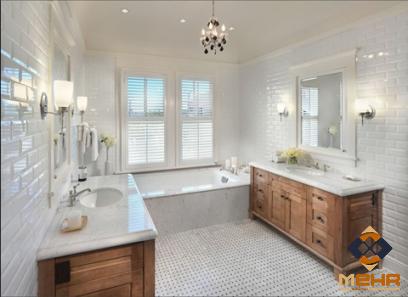Almost all the houses benefit from ceramic tiles on the floor, wall and even outdoors. In addition, other places like bathrooms, kitchens, restaurants, pools, and laboratories use tiles in order to beautify and protect themselves against dirt and filth. One of the most famous commercial types of tiles is VCT. However, a tile refers to a piece of artificial stone of various lengths and widths, the thickness of which does not exceed a few millimeters, and has a polished and glassy surface that usually contains patterns and details. Manufactured tile is generally ceramic or terracotta, which has a very important and special application in construction. Tiles are often used in bathrooms, toilets, kitchens, floors and walls.  Ceramics and tiles have been used in the construction of cities and houses since ancient times. Traces of these building materials can be seen in the remains of ancient cities. Even today, these materials are still popular because the beauty and stability of ceramics or tiles is comparable to natural stone, and these materials are also much cheaper. However, the huge variety of tiles can create problems for us and make it impossible for us to choose the best and most suitable model.
Ceramics and tiles have been used in the construction of cities and houses since ancient times. Traces of these building materials can be seen in the remains of ancient cities. Even today, these materials are still popular because the beauty and stability of ceramics or tiles is comparable to natural stone, and these materials are also much cheaper. However, the huge variety of tiles can create problems for us and make it impossible for us to choose the best and most suitable model. 
Commercial Floor Tile Types
In order to cover a floor, there are various types of tiles. Here are some of the most-used commercial types, represented below. Travertine: One of the porous natural stones utilized nowadays in architecture and interior design is travertine, a form of white limestone. It is important to be aware that travertine tiles were used to construct temples, spas, and statues in classical Italy. Today, both inside and outside of buildings, travertine is one of those stones employed due to its strength. Ceramic: Clay serves as the primary component of ceramic tiles, which are then formed into square ceramics. All ceramic tiles are preferable to porcelain stoneware because they are more resistant to breakage, have less impurities, and are more long-lasting. In many indoor places today, including private lobbies, reception areas, kitchens, and bathrooms, ceramic flooring is employed. 
Commercial Bathroom Tile Types
Smart design with commercial tiles is typically required in homes, especially when the building space is not ample, to make a small bathroom appear larger. To avoid making the bathroom appear smaller, you should be very careful when selecting the color and design of the tiles and other items used inside. Pay close attention to the environment’s cleanliness, peace, and beauty while designing it, and choose all the components more carefully. Be cautious when dealing with little bathroom tile models, their color and appearance, the sink, toilet, and flush, etc.  The best ceramic tiles for a tiny bathroom are those that reflect light more effectively. Therefore, glossy small-size bathroom tiles are preferable. Even while certain tiles are particularly beautiful and seem to have a matt appearance, they are not appropriate for tiny spaces. Using a matt toilet reduces the size of the room. Ceramics for small bathrooms should not only blend in with the rest of the design, but also enhance and expand the room virtually. Designs with obvious flowers are typically suitable for smaller rooms. These patterns give the wall a three-dimensional appearance, making it seem bigger than it actually is. In this area, checkered patterns are inappropriate, and ceramic stripes and one-way lines work better in smaller restrooms.
The best ceramic tiles for a tiny bathroom are those that reflect light more effectively. Therefore, glossy small-size bathroom tiles are preferable. Even while certain tiles are particularly beautiful and seem to have a matt appearance, they are not appropriate for tiny spaces. Using a matt toilet reduces the size of the room. Ceramics for small bathrooms should not only blend in with the rest of the design, but also enhance and expand the room virtually. Designs with obvious flowers are typically suitable for smaller rooms. These patterns give the wall a three-dimensional appearance, making it seem bigger than it actually is. In this area, checkered patterns are inappropriate, and ceramic stripes and one-way lines work better in smaller restrooms. 
Commercial Floor Tile for Restaurants
Restaurants are other places that can hardly be imagined without commercial tiles. Their floor tile has some types which are listed below. Non-porcelain Ceramics: Non-porcelain ceramics, which resemble porcelain ceramic, are also known as ordinary ceramics. Density is the primary distinction between porcelain and non-porcelain. Non-ceramic materials have a lower density, which makes them less durable and more porous. Because ordinary or non-porcelain ceramics are typically less expensive, many individuals opt to utilize them instead of porcelain ceramics. Remember that impacting non-porous ceramics will result in cracking, so it should only be placed by experts. 










Your comment submitted.